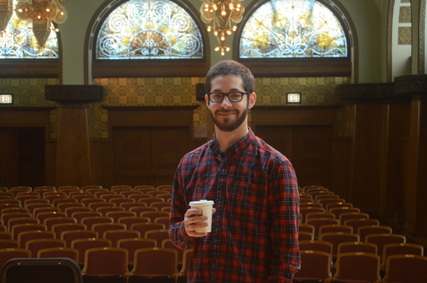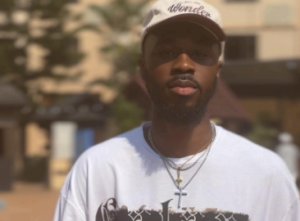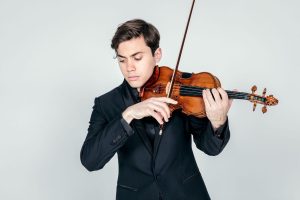In the last Spring of their Master’s Degree at Roosevelt University, composer Jonathan Hannau, pianist Stephen Uhl, and Tenor Matthew Peckham were able to premiere a few works. Their collaboration provides a perspective on how a composition is realized.
These pieces include Hannau’s Obsidian Wasteland for piano, and Pierrot Songs for voice and piano. These also represent a significant period for Hannau in his development as a composer.
“I started [composing] towards the end of my sophomore year at Boston University,” Hannau said. “When I transferred is when I started composing. So I guess I was 20 years old. So I’ve been composing for five years now.”
These five years hold poignancy for Hannau, as they represent the dedication it takes to hone a craft. Surprisingly, it wasn’t until recently that he felt his work truly reflected himself.
|
“I finally feel like I’m writing me, rather than someone else,” Hannau said. “Only this year, actually, only in the last year of my master’s degree at Roosevelt, did I finally get comfortable even writing music. Before that, everything was always a struggle, or there was a lot to think about, but after a full year of intense work in my first year, I finally broke out of my shell, or something clicked, and now I write music that I want to hear and want to explore.”
Where Hannau is exploring is in an area referred to by classical musicians as ‘new music.’ Hannau works with sounds, in building a landscape of timbres. “I have a database of timbres I like to keep in my head,” Hannau said. “Well, it really goes piece to piece. With this one (Obsidian Wasteland), I was trying to think how am I going to start it, and when I went with the mallet in the low register, I was like, ‘I love this gong-like sound’ and then I just went from there.”
|
“I finally feel like I’m writing me, rather than someone else,”
– Jonathan Hannau |
“When I was writing this piece, I was at a piano and I just started messing around with everything,” Hannau said. “I was like, ‘How am I going to build this language?” I also didn’t want to pick up too many sounds, because there is a danger that comes if you use too many different timbral things, of how do you shape the relationship with each one, so I try to create kind of a line with them in my own way.”
In Hannau’s case, he has been fortunate to find people with which he can build a rapport.
“I like to work with people and I like to collaborate,” Hannau said. “So, the first step to writing a piece for me is finding people who would be willing to perform it, like these two (Stephen and Matt.) They asked me for a piece, and finally I was able to sit down and work that piece out for them. I tried to tailor it as much as I could to [their] styles, but also still make it my own voice as well.”
This creates an interesting bond between performer and composer. To a certain extent, what Matt and Stephen bring to the table is just as much a part of the creative process.
“People are writing music with a reason, so you have to perform it with a reason,” Matthew Peckham said. “Usually what’s in front of you isn’t something that has been studied and rehashed for years and years, so you really have to be a scholar about it. Go in there, and say, why is this happening? Why are these notes happening? Why is this texture happening?”
This attention to detail becomes more crucial as the process goes on. From the perspective of performer, sometimes the hardest part of learning a piece is the beginning.
“One of the best pieces of advice I received about performing new music was when I was back in undergrad,” Stephen Uhl said. “And my teacher, he told me… well, I came to the lesson very distressed and I had the right notes, and I even had the extended technique, and I asked him, ‘How do you do this, What’s your approach?’ and he takes a moment, and then he said ‘Pretend Beethoven’s name is on the upper right-hand corner.’ And I think that’s a starting point.”
|
“[…] he said ‘Pretend Beethoven’s name is on the upper right-hand corner.’ And I think that’s a starting point.”
– Stephen Uhl |
It’s this treatment of the music that sets apart someone as capable of working in new music. The attention to detail, although demanding, is extremely rewarding.
“I think audience members can tell,” Uhl said. “even a person that’s never picked up an instrument, can tell if the delivery of a specific piece is successful or not. With this music, the success of it does depend on delivering precise colors within artistic freedom. Realizing that when I play Beethoven and Rachmaninoff is so freeing because I can listen to that degree of the types of colors and sounds the piano is creating.” Getting experience in both traditional and nontraditional forms serves as a frame of reference. Understanding of one greatly informs the other. “I’ve been training as an opera singer and there’s a very specific vocal timbre that’s considered beautiful,” Peckham said. “I love to do something where I don’t have to sing beautifully. So, I get to use a lot of straight-tone, a lot of really clear register breaks, and I love that the second piece is sort of a caricature of a singer. So, I get to overdo the scooping, and the sliding, the straight-tone, and the vibrato.” This dynamic is not just created by the performer, though. There is something to be said about a composer that can foster this kind of relationship. |
|
These works represent what composers are trying to acheive with their work. These works not only push boundaries, but create an essence entirely of its own.
“What is to say that the only way to play the piano is on the keys?” Hannau said. “That whole thing is open, that is such a world in there. So, why are we limiting? or why are we trained to limit ourselves? because the sounds are beautiful.” |
We were also fortunate enough to record both Obsidian Wasteland and Pierrot Songs. You can find that below, as well.













Be First to Comment